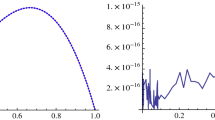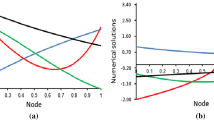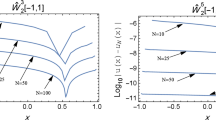Abstract
Many problems arising in different fields of sciences and engineering can be reduced, by applying some appropriate discretization, either to a system of integrodifferential algebraic equations or to a sequence of such systems. The aim of the present analysis is to implement a relatively recent computational method, reproducing kernel Hilbert space, for obtaining the solutions of integrodifferential algebraic systems of temporal two-point boundary value problems. Two extended inner product spaces W[0, 1] and H[0, 1] are constructed in which the boundary conditions of the systems are satisfied, while two smooth kernel functions R t (s) and r t (s) are used throughout the evolution of the algorithm in order to obtain the required grid points. An efficient construction is given to obtain the numerical solutions for the systems together with an existence proof of the exact solutions based upon the reproducing kernel theory. In this approach, computational results of some numerical examples are presented to illustrate the viability, simplicity, and applicability of the algorithm developed.



Similar content being viewed by others
References
Ascher UM, Petzold LR (1998) Computer methods for ordinary differential equations and differential-algebraic equations. SIAM, Philadelphia
Brenan KE, Campbell SL, Petzold LR (1996) Numerical solution of initial-value problems in differential-algebraic equations (classics in applied mathematics). SIAM, Philadelphia
Hairer E, Wanner G (2004) Solving ordinary differential equations II: stiff and differential algebraic problems (series in computational mathematics). Springer, Berlin
Kunkel P, Mehrmann V (2006) Differential-algebraic equations: analysis and numerical solution (EMS textbooks in mathematics). European Mathematical Society, Switzerland
Lamour R, März R, Tischendorf C (2013) Differential-algebraic equations: a projector based analysis (differential-algebraic equations forum). Springer, Berlin
Pytlak R (1999) Numerical methods for optimal control problems with state constraints. Springer-Verlag, Berlin
Kubicek M, Hlavacek V (2008) Numerical solution of nonlinear boundary value problems with applications. Dover Publications, New York
Lawder MT, Ramadesigan V, Suthar B, Subramanian VR (2015) Extending explicit and linearly implicit ODE solvers for index-1 DAEs. Comput Chem Eng 82:283–292
Celik E, Bayram M (2004) Numerical solution of differential-algebraic equation systems and applications. Appl Math Comput 154:405–413
Huang J, Jia J, Minion M (2007) Arbitrary order Krylov deferred correction methods for differential algebraic equations. J Comput Phys 221:739–760
Celik E, Bayram M (2005) The numerical solution of physical problems modeled as a systems of differential-algebraic equations (DAEs). J Franklin Inst 342:1–6
Celik E (2004) On the numerical solution of chemical differential-algebraic equations by Pade series. Appl Math Comput 153:13–17
Celik E, Bayram M (2003) Arbitrary order numerical method for solving differential-algebraic equation by Padé series. Appl Math Comput 137:57–65
Ascher UM, Petzold LR (1991) Projected implicit Runge–Kutta methods for differential-algebraic equations. SIAM J Numer Anal 28:1097–1120
Trent A, Venkataraman R, Doman D (2004) Trajectory generation using a modified simple shooting method In: Aerospace Conference, Proceedings: 2004 IEEE, vol 4, pp 2723–2729
Holsapple RW, Venkataraman R, Doman D (2004) New, fast numerical method for solving two-point boundary-value problems. J Guid Control Dyn 27:301–304
Zhao J (2007) Highly accurate compact mixed methods for two point boundary value problems. Appl Math Comput 188:1402–1418
Cash JR, Wright MH (1991) A deferred correction method for nonlinear two-point boundary value problems: implementation and numerical evaluation. SIAM J Sci Stat Comput 12:971–989
Cash JR, Moore DR, Sumarti N, Daele MV (2003) A highly stable deferred correction scheme with interpolant for systems of nonlinear two-point boundary value problems. J Comput Appl Math 155:339–358
Jankowski T (2003) Samoilenko’s method to differential algebraic systems with integral boundary conditions. Appl Math Lett 16:599–608
Amodio P, Mazzia F (1997) Numerical solution of differential algebraic equations and computation of consistent initial/boundary conditions. J Comput Appl Math 87:135–146
Abu Arqub O (2016) Approximate solutions of DASs with nonclassical boundary conditions using novel reproducing kernel algorithm. Fundam Inform 146:231–254
Abu Arqub O (2016) The reproducing kernel algorithm for handling differential algebraic systems of ordinary differential equations. Math Methods Appl Sci 39:4549–4562
Kumar S, Kumar A, Argyros IK (2016) A new analysis for the Keller–Segel model of fractional order. Numer Algorithms. doi:10.1007/s11075-016-0202-z
Kumar S, Kumar A, Baleneu D (2016) Two analytical methods for time-fractional nonlinear coupled Boussinesq–Burger’s equations arise in propagation of shallow water waves. Nonlinear Dyn 85:699–715
Yin XB, Kumar S, Kumar D (2015) A modified homotopy analysis method for solution of fractional wave equations. Adv Mech Eng 7:1–8
Kumar S, Kumar D, Singh J (2016) Fractional modelling arising in unidirectional propagation of long waves in dispersive media. Adv Nonlinear Anal 5:383–394
Alquran M, Al-Khaled K, Chattopadhyay J (2015) Analytical solutions of fractional population diffusion model: residual power series. Nonlinear Stud 22:31–39
Alquran M, Al-Khaled K, Sarda T, Chattopadhyay J (2015) Revisited Fisher’s equation in a new outlook: a fractional derivative approach. Phys A 438:81–93
Jaradat HM, Awawdeh F, Al-Shara’ S, Alquran M, Momani S (2015) Controllable dynamical behaviors and the analysis of fractal burgers hierarchy with the full effects of inhomogeneities of media. Rom J Phys 60:324–343
Alquran M, Jaradat HM, Al-Shara’ S, Awawdeh F (2015) A new simplified bilinear method for the N-soliton solutions for a generalized FmKdV equation with time-dependent variable coefficients. Int J Nonlinear Sci Numer Simul 16:259–269
Lin Y, Cui M, Yang L (2006) Representation of the exact solution for a kind of nonlinear partial differential equations. Appl Math Lett 19:808–813
Zhoua Y, Cui M, Lin Y (2009) Numerical algorithm for parabolic problems with non-classical conditions. J Comput Appl Math 230:770–780
Yang LH, Lin Y (2008) Reproducing kernel methods for solving linear initial-boundary-value problems. Electron J Differ Equ 2008:1–11
Wang WY, Han B, Yamamoto M (2013) Inverse heat problem of determining time-dependent source parameter in reproducing kernel space. Nonlinear Anal Real World Appl 14:875–887
Jiang W, Lin Y (2011) Representation of exact solution for the time fractional telegraph equation in the reproducing kernel space. Commun Nonlinear Sci Numer Simul 16:3639–3645
Wang Y, Du M, Tan F, Li Z, Nie T (2013) Using reproducing kernel for solving a class of fractional partial differential equation with non-classical conditions. Appl Math Comput 219:5918–5925
Jiang W, Lin Y (2010) Approximate solution of the fractional advection–dispersion equation. Comput Phys Commun 181:557–561
Jiang W, Chen Z (2014) A collocation method based on reproducing kernel for a modified anomalous subdiffusion equation. Numer Methods Partial Differ Equ 30:289–300
Geng FZ, Cui M (2012) A reproducing kernel method for solving nonlocal fractional boundary value problems. Appl Math Lett 25:818–823
Li X, Wu B (2015) Approximate analytical solutions of nonlocal fractional boundary value problems. Appl Math Model 39:1717–1724
Abu Arqub O, Maayah B (2016) Solutions of Bagley-Torvik and Painlevé equations of fractional order using iterative reproducing kernel algorithm. Neural Comput Appl. doi:10.1007/s00521-016-2484-4
Abu Arqub O, Al-Smadi M, Momani S, Hayat T (2016) Numerical solutions of fuzzy differential equations using reproducing kernel Hilbert space method. Soft Comput 20:3283–3302
Abu Arqub O, Al-Smadi M, Momani S, Hayat T (2016) Application of reproducing kernel algorithm for solving second-order, two-point fuzzy boundary value problems. Soft Comput. doi:10.1007/s00500-016-2262-3
Abu Arqub O (2015) Adaptation of reproducing kernel algorithm for solving fuzzy Fredholm–Volterra integrodifferential equations. Neural Comput Appl. doi:10.1007/s00521-015-2110-x
Jiang W, Chen Z (2013) Solving a system of linear Volterra integral equations using the new reproducing kernel method. Appl Math Comput 219:10225–10230
Yang LH, Shen JH, Wang Y (2012) The reproducing kernel method for solving the system of the linear Volterra integral equations with variable coefficients. J Comput Appl Math 236:2398–2405
Abu Arqub O, Al-Smadi M, Shawagfeh N (2013) Solving Fredholm integro-differential equations using reproducing kernel Hilbert space method. Appl Math Comput 219:8938–8948
Abu Arqub O, Al-Smadi M (2014) Numerical algorithm for solving two-point, second-order periodic boundary value problems for mixed integro-differential equations. Appl Math Comput 243:911–922
Geng FZ, Qian SP (2013) Reproducing kernel method for singularly perturbed turning point problems having twin boundary layers. Appl Math Lett 26:998–1004
Geng FZ, Qian SP, Li S (2014) A numerical method for singularly perturbed turning point problems with an interior layer. J Comput Appl Math 255:97–105
Geng FZ, Qian SP (2015) Modified reproducing kernel method for singularly perturbed boundary value problems with a delay. Appl Math Model 39:5592–5597
Acknowledgements
The authors express their thanks to unknown referees for the careful reading and helpful comments.
Author information
Authors and Affiliations
Corresponding author
Ethics declarations
Conflict of interest
The authors declare that they have no conflict of interest.
Rights and permissions
About this article
Cite this article
Abu Arqub, O., Rashaideh, H. The RKHS method for numerical treatment for integrodifferential algebraic systems of temporal two-point BVPs. Neural Comput & Applic 30, 2595–2606 (2018). https://doi.org/10.1007/s00521-017-2845-7
Received:
Accepted:
Published:
Issue Date:
DOI: https://doi.org/10.1007/s00521-017-2845-7




